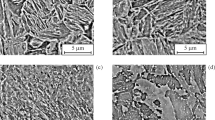Conclusions
-
1.
A necessary and sufficient condition for avalanche fracture of the tough microcleavage type at low temperature and with developed plastic strain in the neck is the attainment of the critical tensile stress σ1max during loading. This stress is equal to the microcleavage stress of the given structure and is the stress at which a nucleated submicrocrack becomes a Griffith crack and initiates fracture.
-
2.
The resistance of microcleavage in the initial (undeformed) state is determined by structural parameters of the steel d and Kr. The change in this resistance during deformation depends on the strain-hardening parameters A and n.
-
3.
The sharp drop in the true fracture stress Sk near the ductile-brittle transition temperature Tb and the strain dependence of the cold-shortness threshold are conditional upon the character of the change in the resistance of the steel to microcleavage with a change in strain.
-
4.
The characteristic of avalanche tough fracture of steel Sk and parameters of the stress state in the neck j, L, and B can be used to determine the resistance of deformed steel to microcleavage Rmce without the attainment of the cold-shortness temperature in an experiment.
Similar content being viewed by others
Literature Cited
J. F. Knott Principles of Fracture Mechanics [Russian translation], Metallurgiya, Moscow (1978).
A. Ya. Krasovskii, Brittleness of Metals at Low Temperatures [in Russian], Naukova Dumka, Kiev (1980).
Yu. Ya. Meshkov, Physical Principles of the Fracture of Steel Structures [in Russian], Naukova Dumka, Kiev (1981).
G. V. Uzhik, Cohesive and Ultimate Strength of Metals [in Russian], Izd. Akad. Nauk, SSSR, Moscow (1950).
G. P. Zlenko, Yu. Ya. Meshkov, G. S. Mettus, and K. L. Frenkel', “Determination of the resistance of steel to brittle fracture on specimens with an annular notch,” Zavod. Lab., No. 2, 74–76 (1983).
V. N. Gridnev, V. G. Gavrilyuk, and Yu. Ya. Meshkov, Strength and Ductility of Cold-Worked Steel [in Russian], Naukova Dumka, Kiev (1974).
N. N. Davidenkov and N. I. Spiridonova, “Analysis of the stress state in the neck of a tensioned specimen” Zavod. Lab.,11, 583–593 (1945).
P. W. Bridgman, Investigation of Large Plastic Strains and Fracture [Russian translation], IL, Moscow (1955).
J. T. Hahn, B. L. Averbach, V. S. Owen, and M. Cohn, “Occurrence of a cleavage microcrack in polycrystalline iron and steel,” in: Atomic Mechanicm of Fracture [Russian translation], Metallurgizdat, Moscow (1963), pp. 108–134.
L. A. Kopel'man, Resistance of Welded Elements to Brittle Fracture [in Russian], Mashinostroenie, Leningrad (1978).
Yu. Ya. Meshkov, G. A. Pakharenko, and T. N. Serditova, “Relationship between the stresses corresponding to the brittle strength and resistance to ductile fracture of low-carbon steel in uniaxial tension,” Metallofizika, No. 4, 61–64 (1983).
N. N. Davidenkov and P. S. Sakharov, “Effect of work hardening on the brittleness of steel,’ Zh. Tekh. Fiz., No. 7, 675–690 (1937).
Yu. Ya. Meshkov, G. A. Pakharenko, and S. N. Sedykh, “Structural criterion of the structural strength of steel,” in: Thermal and Thermomechanical Strengthening of Metals [in Russian], O-Vo “Znanie,” Moscow (1978), pp. 137–143.
L. M. Gladshtein and N. B. Larionova, “Effect of ferrite grain size on strain and fracture characteristics of structural steel,” Probl. Prochn., No. 7, 67–75 (1982).
DahI, H. Hengstenberg, and H. Behrens, “Das Verhalten unlegierter und niedriglaegierter Banstahle und der Streckgrenze in Ahangigkeit von Korngrobe, Temperature, Vorverforming und alterung,” Stahl Eisen,87, No. 17, 1030–1047 (1967).
Yu. V. Mil'man, “Effect of structural factors on the temperature of the transition of bcc metals to brittle fracture,” Metallofizika,43, 25–41 (1972).
V. I. Trefilov, Yu. V. Mil'man, and S. A. Firstov, Physical Principles of the Strength of Refractory Metals [in Russian], Naukova Dumka, Kiev (1975).
Additional information
Institute of Metal Physics, Academy of Sciences of the Ukrainian SSR, Kiev. Translated from Problemy Prochnosti, No. 9, pp. 44–49, September, 1984.
Rights and permissions
About this article
Cite this article
Serditova, T.N. Study of the critical fracture stress of steel in uniaxial tension. Strength Mater 16, 1264–1270 (1984). https://doi.org/10.1007/BF01530002
Received:
Issue Date:
DOI: https://doi.org/10.1007/BF01530002




